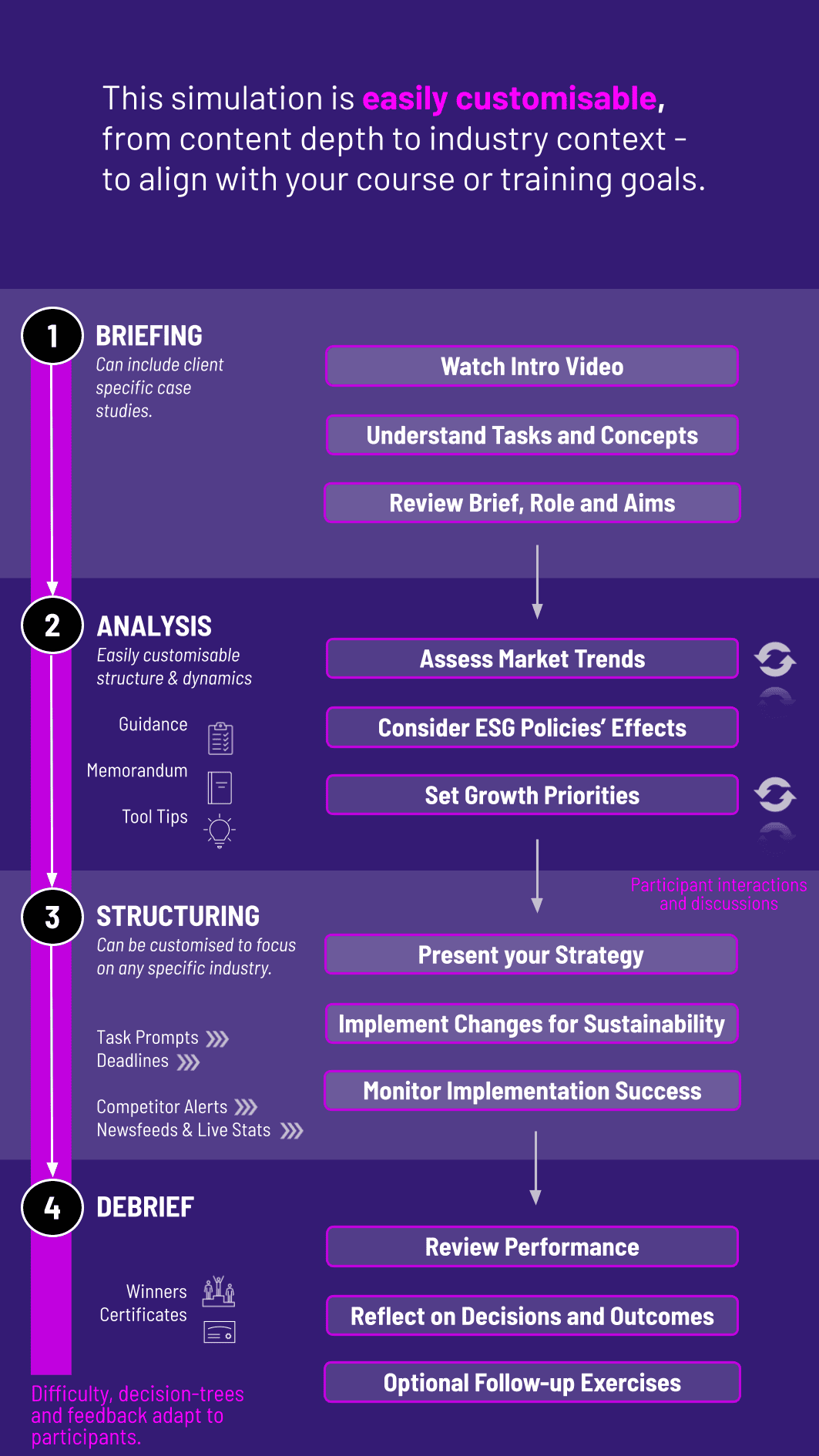
In this Sustainable Growth Strategy Simulation, participants act as corporate leaders balancing profitability, long-term growth, and ESG goals - making strategic decisions under resource constraints, market pressure, and evolving stakeholder expectations.
Strategic growth frameworks (organic vs inorganic)
ESG integration in strategy design
Stakeholder trust and corporate reputation
Financial trade-offs between sustainability and expansion
Innovation and long-term value creation
Market positioning under regulatory and social pressures
Resilience planning and risk mitigation
Cross-functional decision-making
Ethical dilemmas in growth strategies
Balancing global vs local growth objectives


Analyze growth opportunities in new markets, products, or partnerships
Evaluate ESG risks and opportunities alongside financial returns
Allocate budgets across competing initiatives under constraints
Communicate strategy to boards, employees, and investors
Respond to external shocks such as activist campaigns, regulatory changes, or supply chain disruptions
Reflect on trade-offs between expansion and long-term sustainability
By the end of the simulation, participants will be able to:
Apply sustainable growth frameworks to strategic decisions
Balance financial performance with environmental and social impact
Evaluate trade-offs between short-term profit and long-term resilience
Communicate growth strategies effectively to diverse stakeholders
Integrate ESG into core business strategy
Navigate uncertainty and external shocks with adaptability
Strengthen cross-functional collaboration in growth initiatives
Foster innovation as a driver of sustainable growth
Anticipate reputational and regulatory consequences of decisions
Develop a holistic perspective on sustainable business success
The simulation’s flexible structure ensures that these objectives can be calibrated to match the depth, duration, and focus areas of each program, whether in higher education or corporate learning.
The simulation can run in classrooms, workshops, or corporate settings, individually or in teams. Each cycle builds complexity, mirroring the evolution of a company pursuing sustainable growth.
1. Receive a Scenario or Brief: Participants receive a case with growth opportunities, ESG expectations, and financial goals.
2. Analyze the Situation: They assess market conditions, internal resources, and stakeholder pressures.
3. Make Strategic Decisions: Participants allocate resources, set growth priorities, and balance ESG with profitability.
4. Collaborate or Negotiate: In team formats, participants align across roles (finance, sustainability, operations) to reach decisions.
5. Review Results and Reflect: Feedback highlights financial outcomes, stakeholder sentiment, ESG scores, and reputational impacts.
6. Iterate Across Rounds: New developments - regulatory changes, market shifts, or external crises - are introduced, requiring participants to adapt their strategies.
Do participants need prior sustainability knowledge? No. The simulation introduces ESG concepts in context, making it accessible for all backgrounds.
Can it be customized for specific industries? Yes. It can reflect the challenges of tech, retail, energy, finance, and more.
Is this suitable for executive education? Absolutely. It’s designed for both emerging leaders and senior professionals.
Does it include crisis scenarios? Yes. External shocks like climate risks, activist pressure, or regulatory tightening can be built in.
Can it be run in teams? Yes. Team play allows for cross-functional decision-making and debate.
How long does it run? It can be delivered in 2-hour sessions or extended across multi-day courses.
Is there a communication element? Yes. Participants draft memos, board updates, or investor briefings to explain strategies.
What success metrics are used? Financial performance, ESG outcomes, stakeholder trust, and long-term resilience.
Does it apply to universities? Yes. It’s widely applicable in MBA, sustainability, and strategy programs.
Is it online-compatible? Yes. It works in digital, in-person, and hybrid formats.
Alignment of growth decisions with long-term sustainability
Financial and ESG outcomes achieved
Responsiveness to shocks and evolving contexts
Clarity and persuasiveness of strategy communication
Collaboration and decision-making effectiveness
You can also include memo writing and debrief presentations as part of the assessment structure. Additionally, you can also add a built-in peer and self-assessment tool to see how participants rate themselves. This flexibility allows the simulation to be easily integrated by professors as graded courses at universities and by HR at assessment centres at companies.
Join this 20-minute webinar, followed by a Q&A session, to immerse yourself in the simulation.
or
Book a 15-minute Zoom demo with one of our experts to explore how the simulation can benefit you.